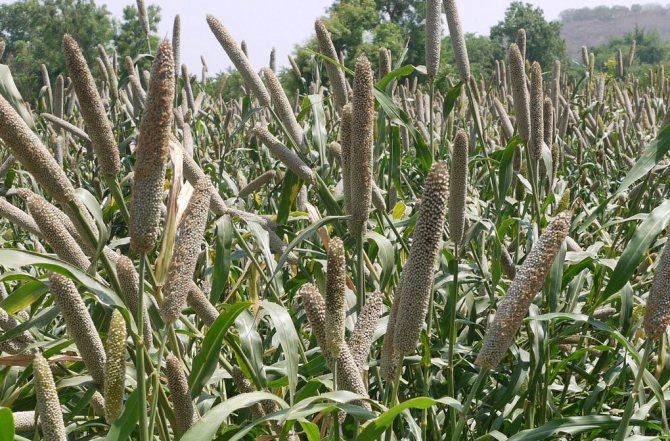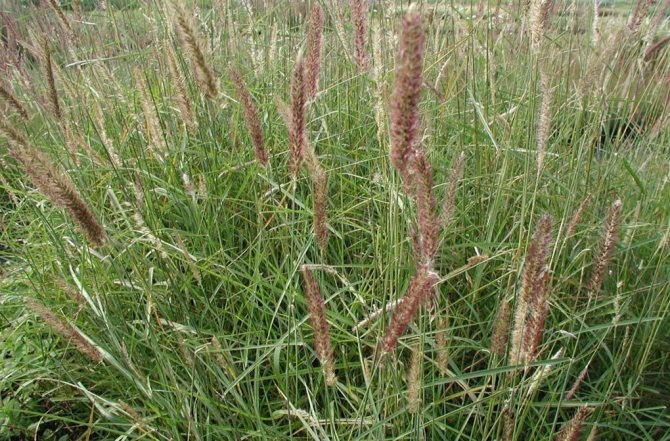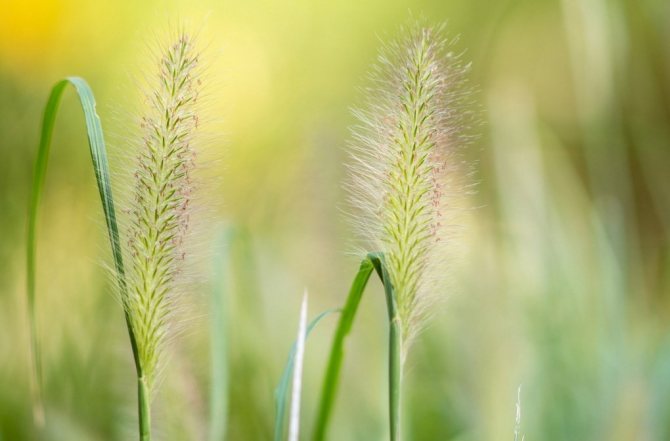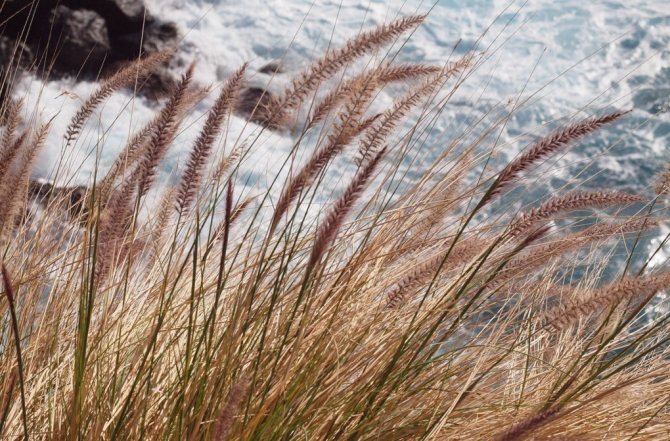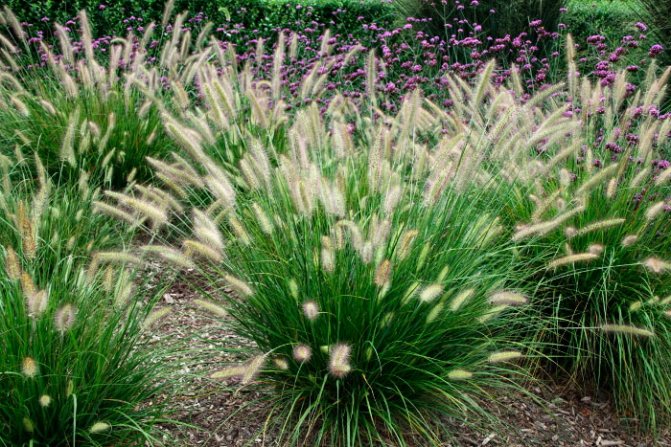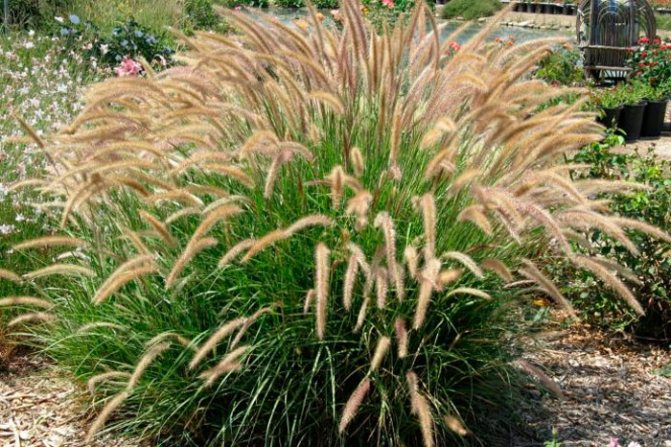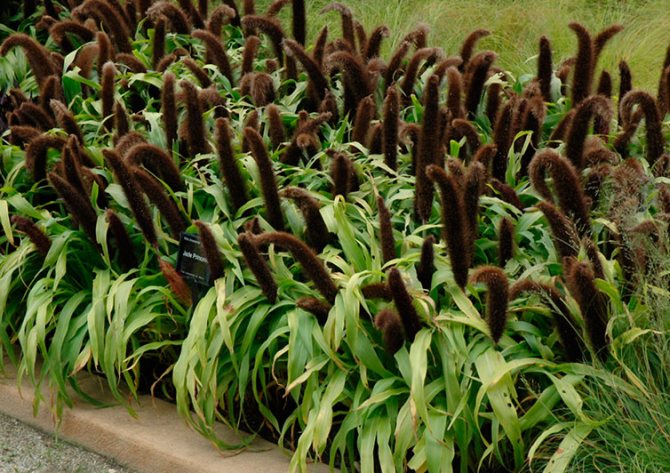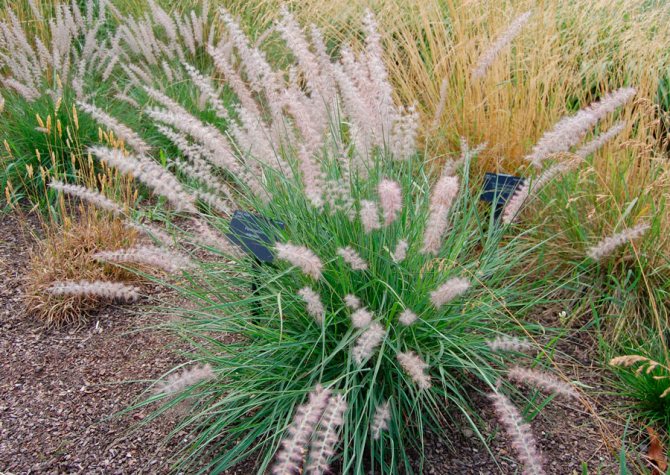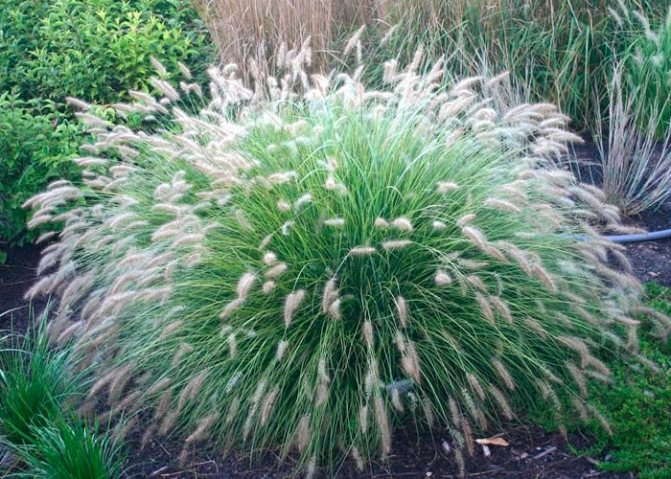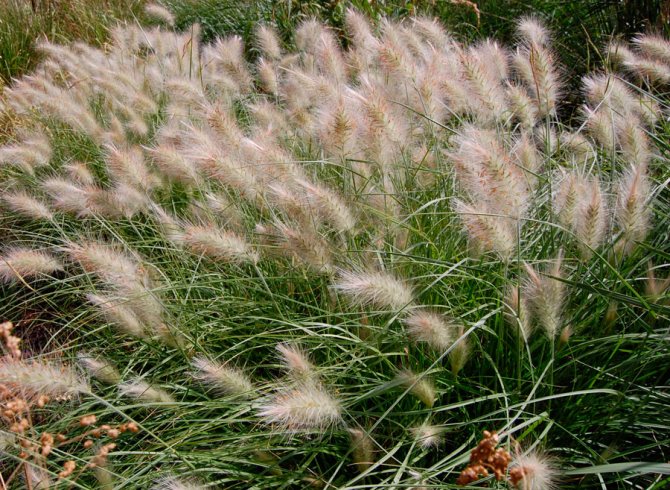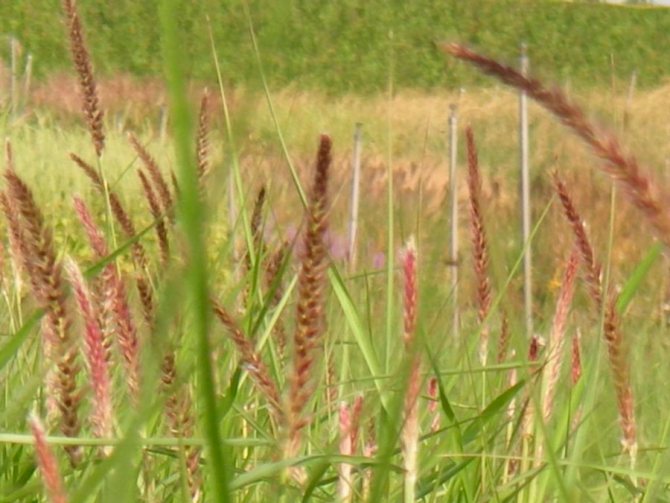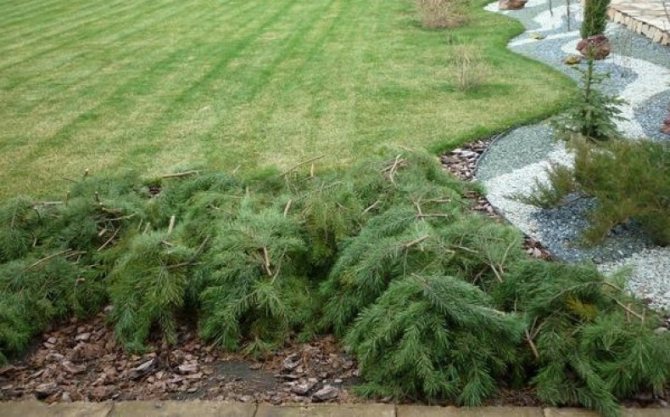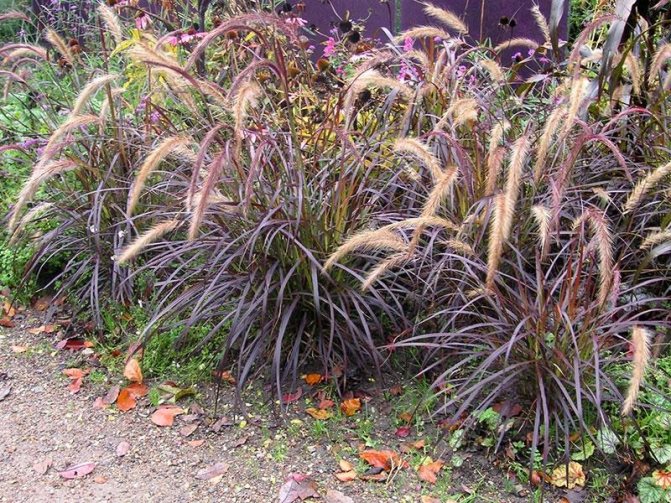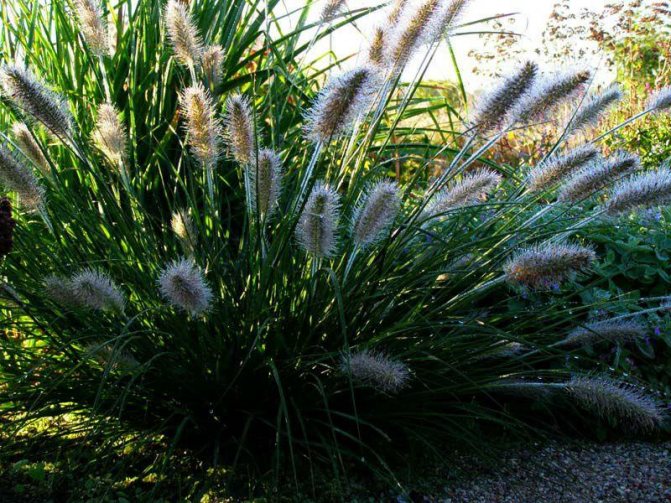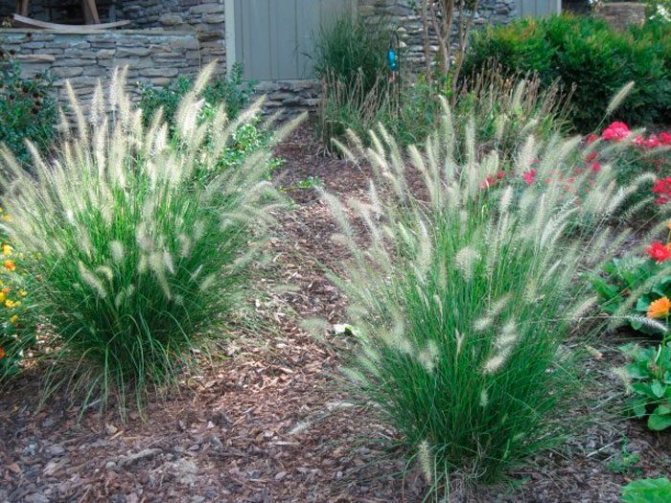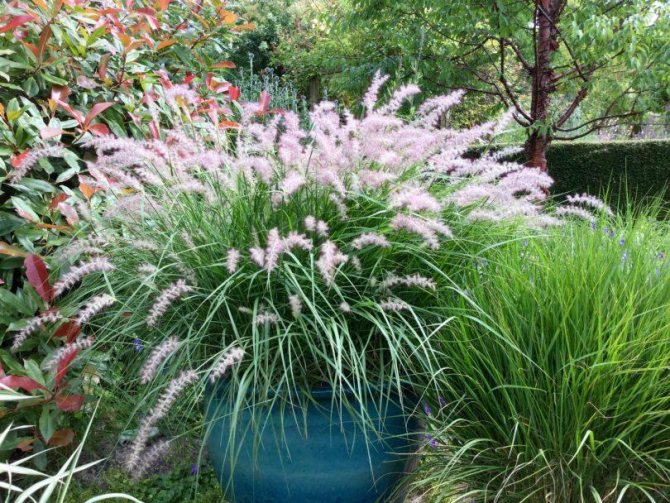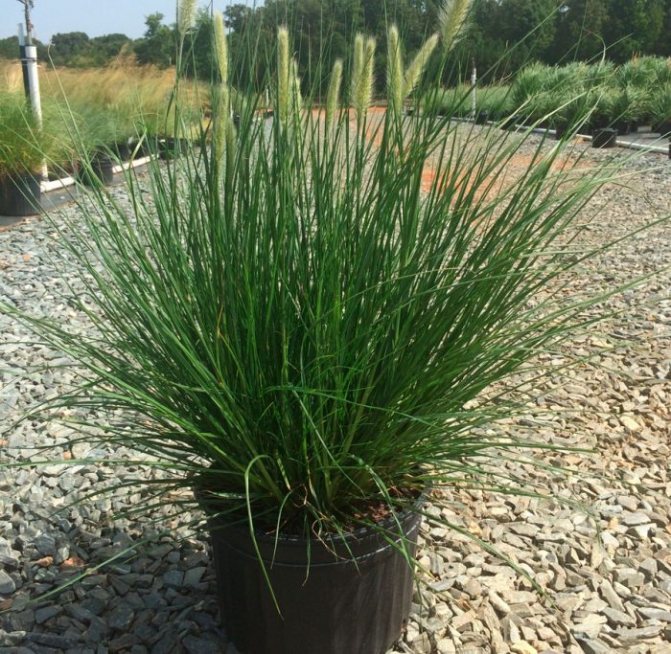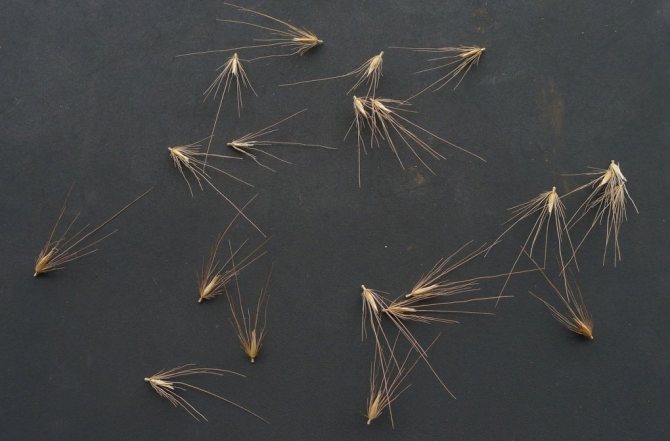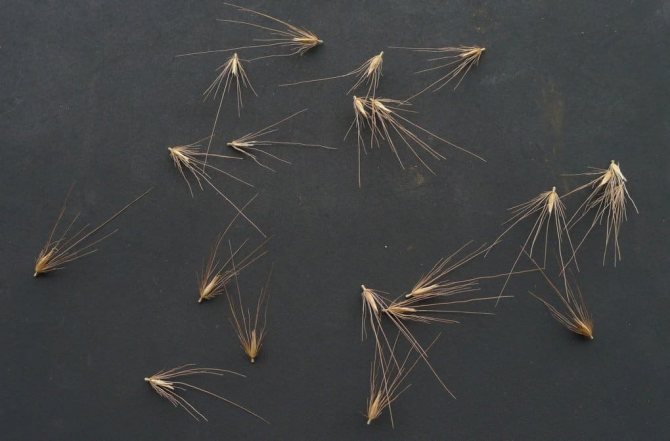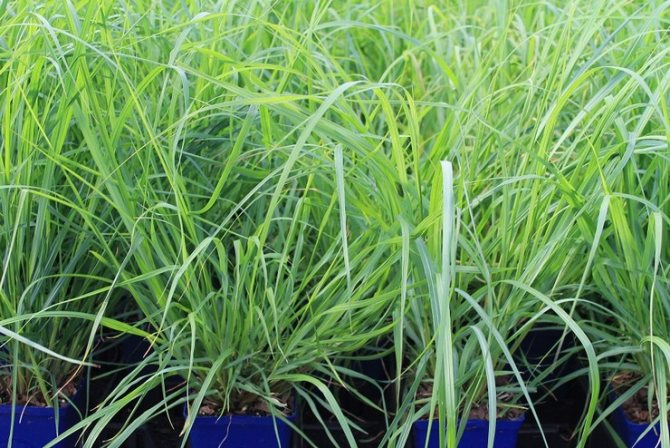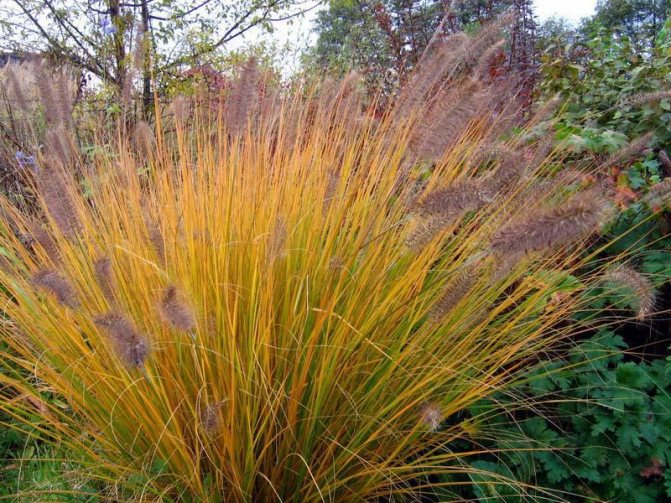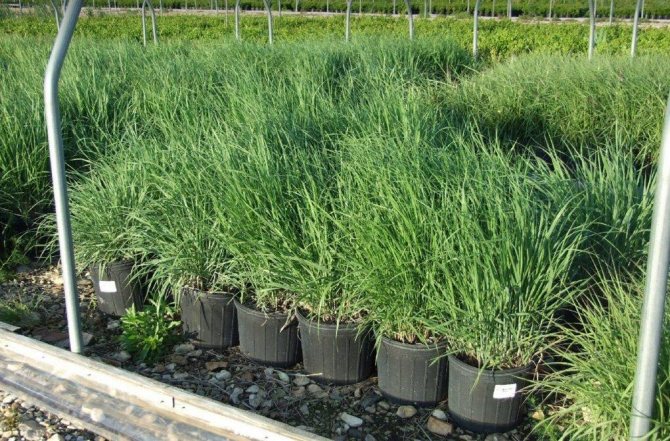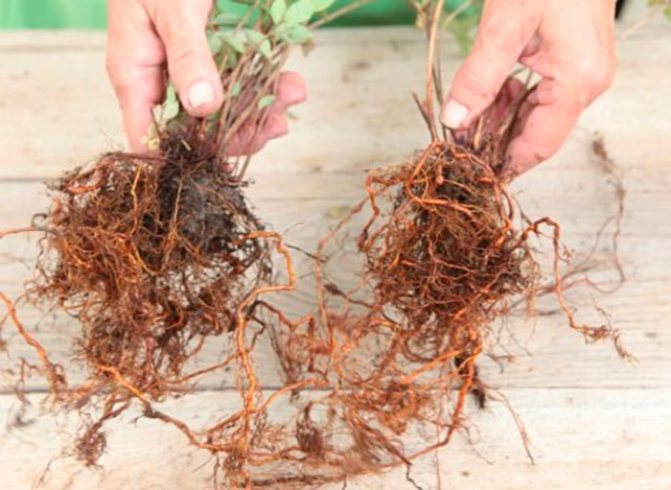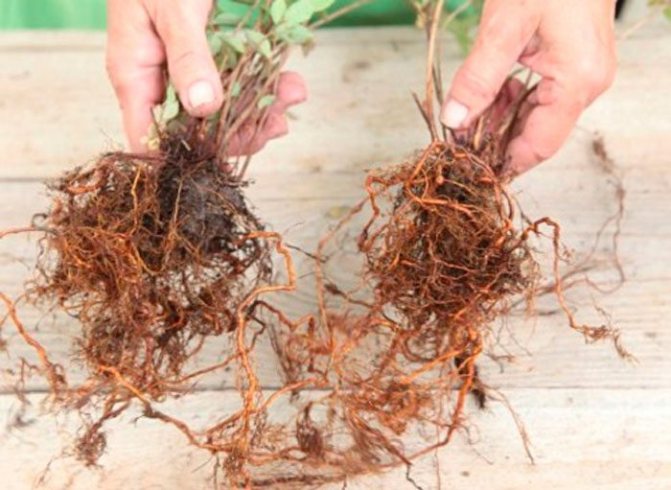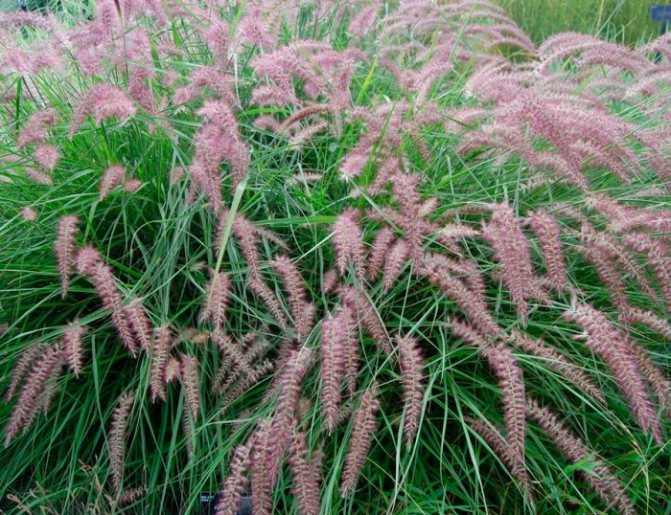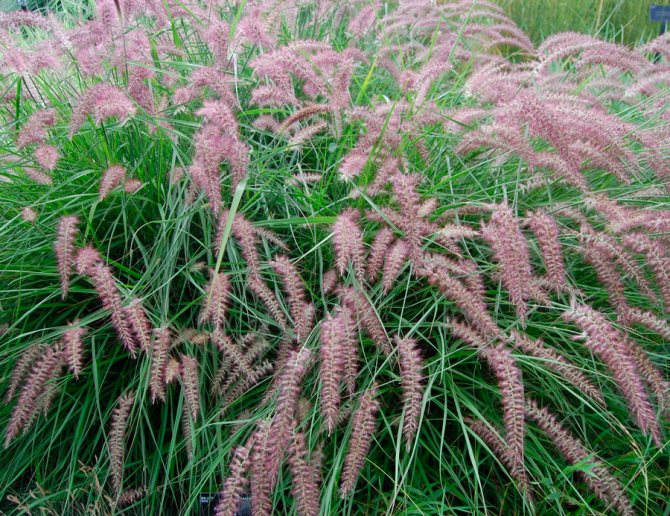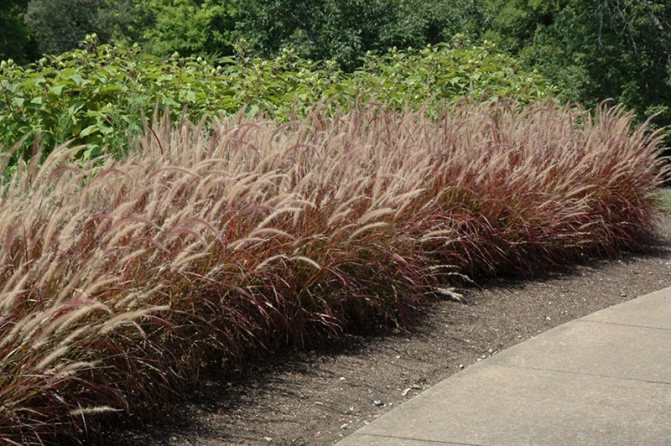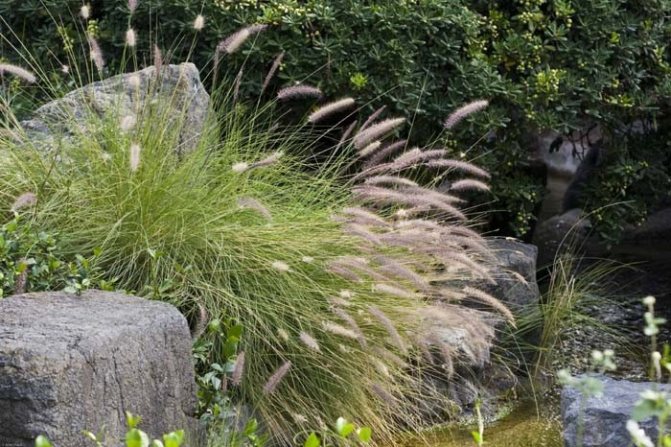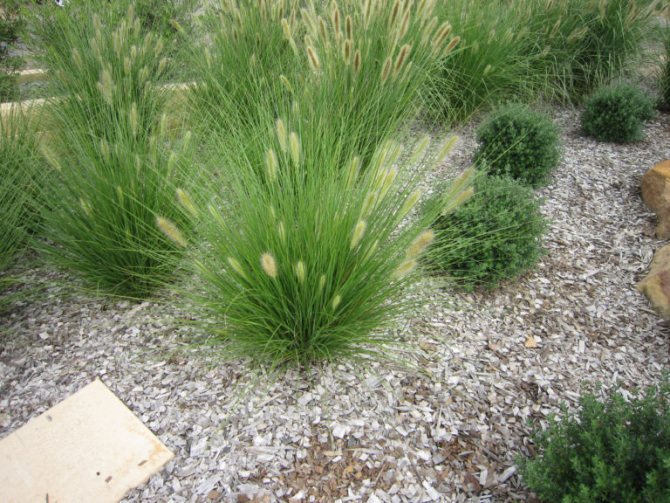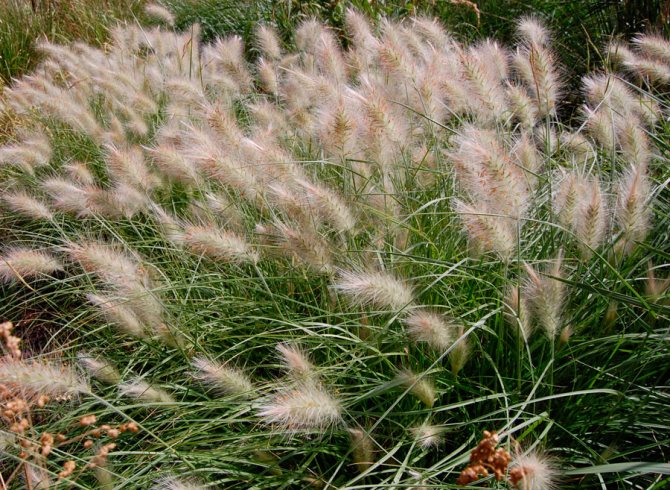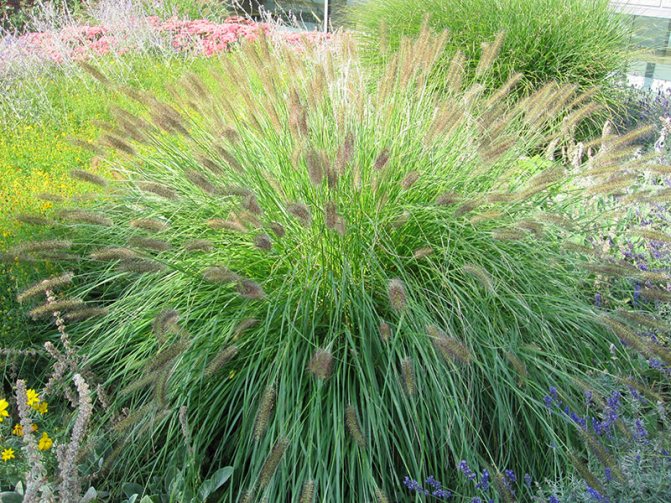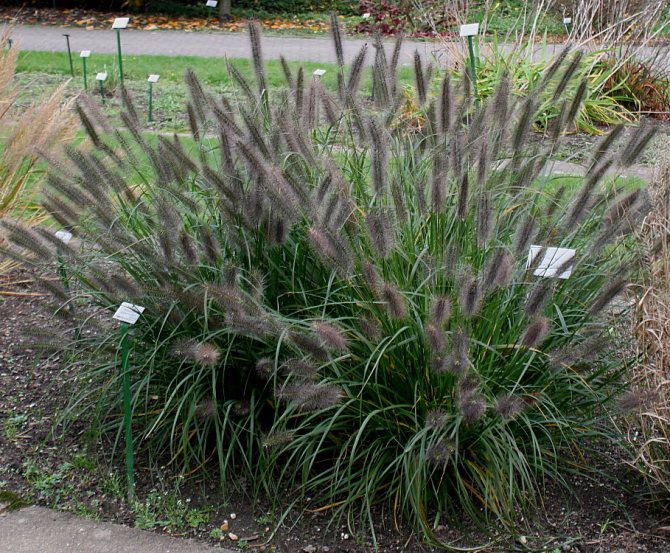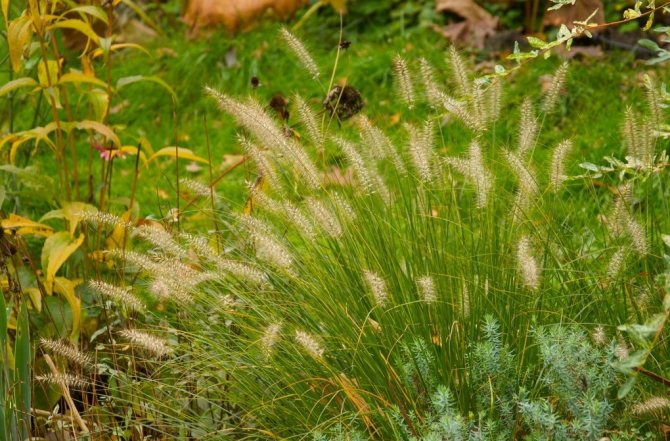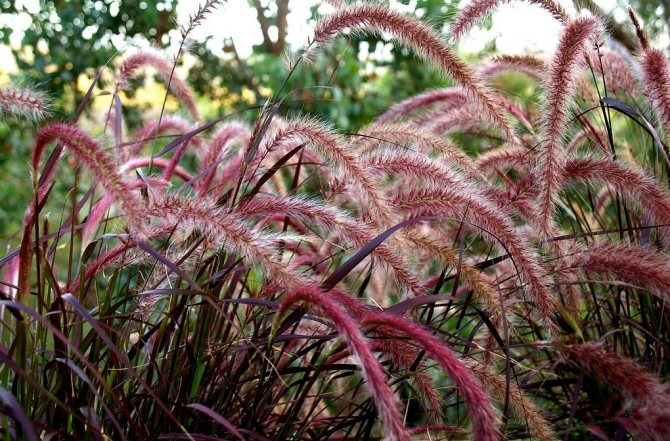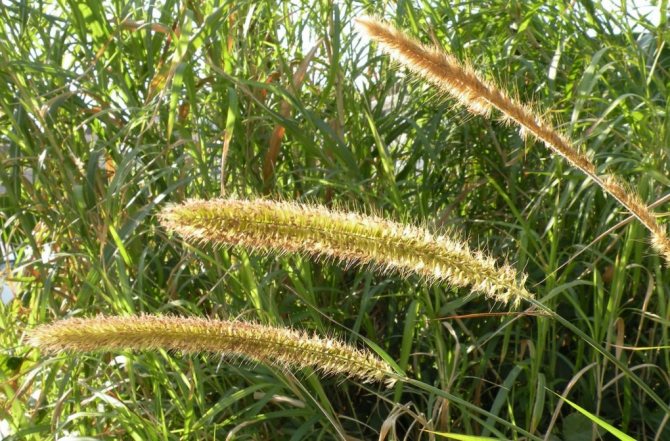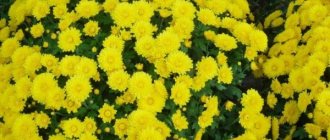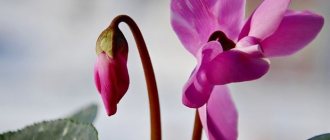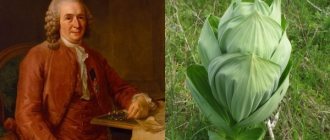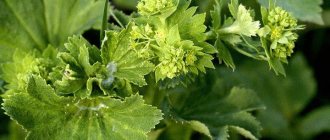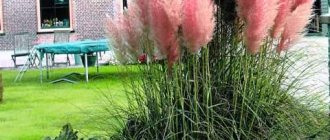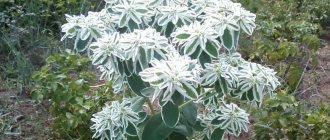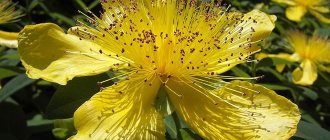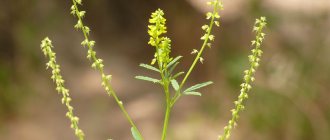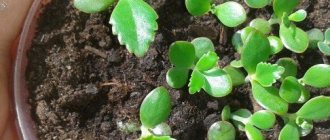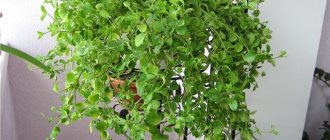A perennial herb, Pennisetum, also called pinnacle, is a member of the Cereal family. This genus unites 130–150 species. In nature, such a plant is mainly found in Africa and South America in temperate zones. The name of this genus was formed from a pair of Latin words, translated as "feather" and "bristle", which is associated with the appearance of the inflorescences. In middle latitudes, such a crop is grown relatively rarely, because it is not highly frost-resistant. But this herbaceous plant has a rather spectacular appearance, so more and more gardeners and designers are turning their attention to it.
Pennisetum foxtail with photo
Pennisetum foxtail is the leader in popularity. This herbaceous plant withstands frost very well, which allows it to be used as a perennial. Its narrow gray-green leaves form semicircular thickets, the height of which varies from 30 to 60 cm. In September, whitish spike-shaped panicles appear above it, which eventually change color to pink or reddish brown. The height of the spikelets reaches 50-80 cm. In the cold summer, the pennisetum does not receive enough sun, which is why it may not set buds. Autumn time colors the leaves of the plant in a corn-yellow color.
This group of pennisetum includes the following varieties:
- "Hameln", very graceful, slightly lower (10-20 cm) from the pure variety. It belongs to the early varieties. It begins to bloom in August.
- Compressum. This variety is slightly taller, reaching 90 cm in height. It blooms with red-brown spike-shaped panicles. Has very good winter hardiness.
- "Japonicum". This variety is not suitable for northern regions. He needs a mild climate. Spike-shaped panicles with white tops rise on erect peduncles to a height of 80 cm.
Pennisetum foxtail also feels very comfortable in wet areas, such as the shore of a pond.
Important! All pennisetum varieties need good lighting, so they need to be planted in a sunny and bright place.
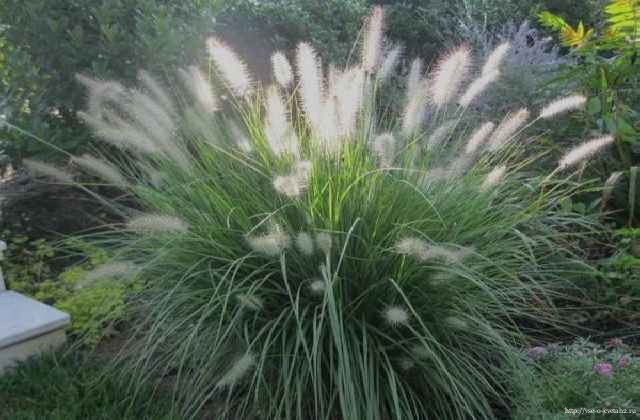
Planting pennisetum in open ground
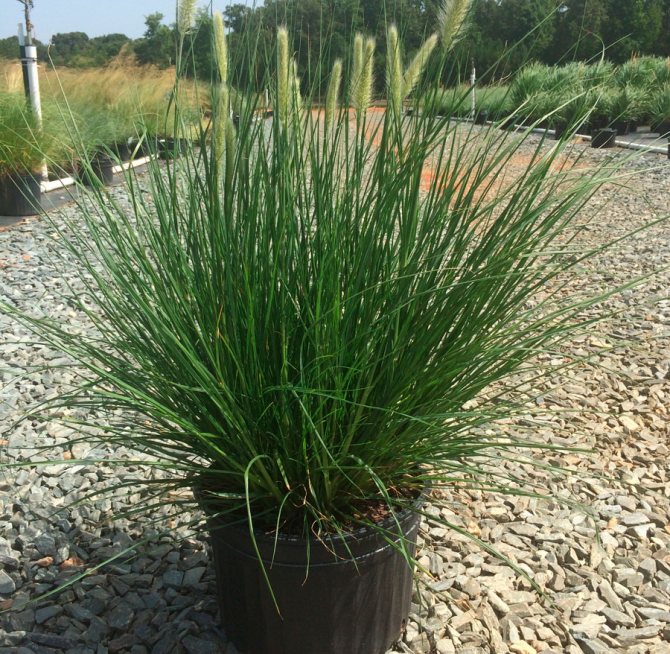

What time to plant
The most popular breeding method for pennisetum in mid-latitudes is seed. The plant is grown through seedlings. Sowing the seeds of the annual pennisetum is carried out in mid-April, for this they use pots or boxes filled with a substrate. Planting seedlings in open soil is carried out in the last days of May. Annuals, if desired, can be sown directly into open soil in early May.
Perennial pennisetum can also be propagated by seed. In order for young bushes to bloom in the current season, they must be sown for seedlings from mid to late February, for this they use peat pots, because such cereals react extremely negatively to the exposure of the root system during the transplantation process. The grown seedlings are planted in the soil directly in these peat cups.
Landing rules
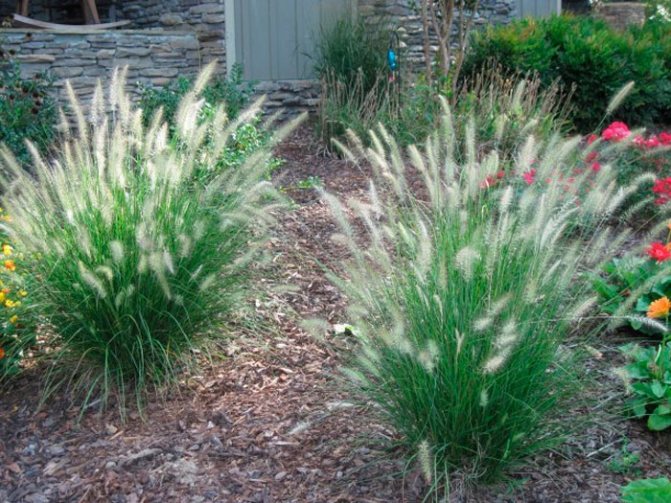

The seeds are evenly distributed over the surface of the previously abundantly moistened soil mixture, then they are pressed into the substrate by a few millimeters. Crops are watered with a spray bottle, and then they are transferred to a well-lit and warm place.The first seedlings will appear after 7 days. They should be provided with artificial lighting, since in February the day is still quite short, and such plants need a lot of light. Planting mature seedlings into open soil is carried out in the last days of May, after the height of the bushes is 10 to 15 centimeters. For planting, you should choose a well-lit and open area. A suitable soil should be nutritious, humus-rich, moist and slightly acidic. Excessively dense, dry or sandy soil is not suitable for growing such a crop.
When planting plants, a distance of 0.6 to 0.8 m should be kept between them. They are planted at the same depth at which they were grown in a container. Such a plant is distinguished by the fact that it grows rather quickly and strongly, while it is able to displace other crops, capturing territories that are not intended for it. To avoid this, the bushes need to be limited; for this, sheets of metal or old slate must be dug around the perimeter of the site no less than half a meter deep. It should also be borne in mind that such a cereal reproduces well by self-sowing.
How to plant pennisetum correctly
Pennisetum is transplanted in the spring. With the help of a rope, you need to outline the shape of the flower bed. The flowerbed looks very nice, the edges of which are vague. Remove soil from the flower bed.
Attention! If the terrain is suitable, some varieties can self-propagate. Therefore, you need to remove excess shoots in the fall.
Ambulance! There are not so many pests and diseases that affect the pennisetum. But over time, old bushes begin to die. The middle spoils first. Therefore, it is necessary to dig up a bush, cut out the middle and destroy it. After that, it is worth planting only strong outer parts.
Reproduction by dividing the bush and planting
The growing gray pennisetum is quite easy to propagate by dividing the bush, as it grows quickly. To do this, in the spring, young shoots should be separated from it along with the rhizome and planted in the desired area. The landing site should be sunny and protected from strong winds. For planting, it is better to prepare the pits in advance by organizing drainage from small stones at the bottom. If the soil has a high density, it should be well loosened.
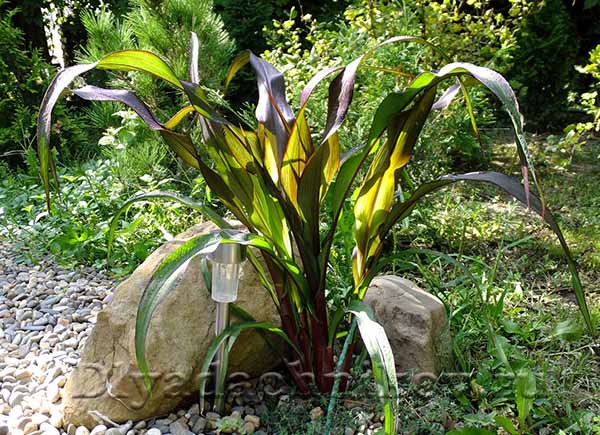

Growing annual varieties
To grow annual varieties, it is necessary to sow seeds in the house in March. It is worth planting sprouted or purchased seedlings in May. Those plants that have wintered, cut to the width of a palm and feed with complex fertilizers. If the plants are old, they need to be separated. When transplanting, do not remove the remnants of the soil from the roots, as the plant can get sick from this.
Watering and pruning! In dry times, plants should be watered abundantly. Peduncles with blossoming ears should be cut to decorate bouquets and create dry compositions.
Pennisetum in landscape design
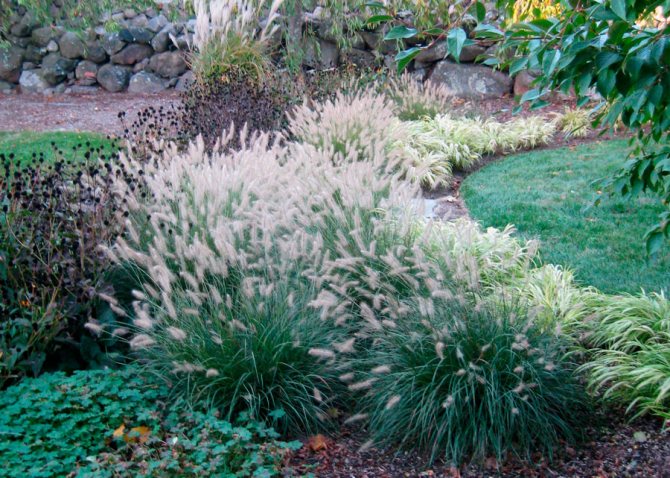

Ornamental cereals, including pennisetum, are quite popular in landscape design and gardening, while they are used both in landscape style and in ordinary planting. The foxtail pennisetum is most often used to create a landscape composition, and it plays the role of a large plant accent. Against the background of pennisetum, such undersized plants as kotula and marigold look good in water compositions.
In an ordinary planting, this culture is suitable for creating a curb. Thanks to this framing, the paths grown on the lawn or in the flower garden of the crop look very impressive. With such a plant, they create beautiful rocky compositions that look very natural, while the foliage of the pennisetum creates a bright accent.This composition can also include plants typical for mountainous areas, for example: rejuvenated, Byzantine chisel, lavender, stone rose or gray fescue.
This plant is suitable for continuous flowering compositions and for mixborders because it has a high decorative effect that changes over time. This plant is also suitable for creating a mono-composition. To do this, it is recommended to plant various types and varieties of such a culture on one site, which will differ in the color of the inflorescences and foliage.
Wintering
If the cultivated variety of Pennisetum is a frost-resistant perennial, then during preparation for winter, its aboveground part does not need to be cut, it will become a natural shelter for the root system of the bush. For the winter, it is recommended to cover the root section with flown leaves or spruce branches, while the layer should be thick enough. With the onset of spring, the shelter must be removed, and the last year's above-ground part of the bush must be cut off.


Varieties and types
More than 150 species of pennisetum grow in the tropics. In the middle lane, only a few of the most frost-resistant species are grown:
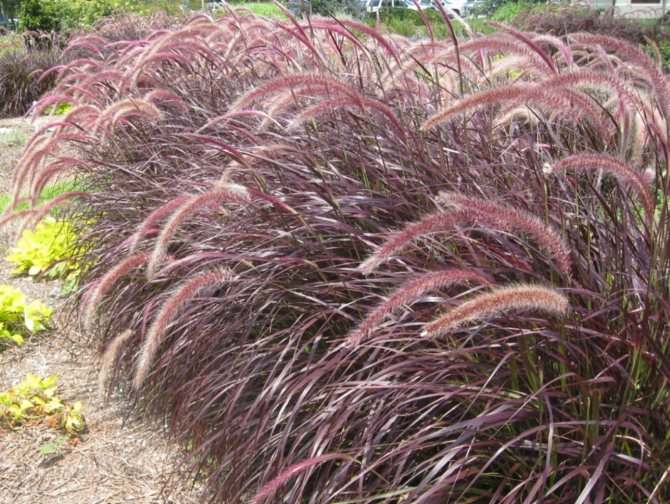

Pennisetum foxtail is the most popular variety. Its natural habitat is the meadows of East Asia and Australia. Plant height reaches 0.9-1.1 m. It forms a lush bush with bright green leaves and whitish or pinkish spikelets. Flowering lasts from August to September. The foxtail pinnate is a frost-resistant plant that can be left in the open field for the winter. When cold weather sets in, the upper part is cut off and covered with spruce branches or covering material.- Pennisetum gameln is a plant with light, cream or beige arched inflorescences. Sometimes they have a reddish or pink tint. The plant tolerates winter well in mid-latitudes. It blooms from late August to mid September. Fluffy inflorescences of pinnate bristles retain their decorative effect even in winter.
- Pennisetum gray, or African millet. This plant has bronze-burgundy leaves, which are 3.5 cm wide. In temperate climates, it is grown as an annual. Dense erect bushes of pennisetum reach a height of two meters. It blooms from July to September.
- Cirrus Purple magesty is a popular variety of African millet. It has dark red leaves, and the color of the inflorescences ranges from pink to maroon. This variety is often called burgundy. Its height reaches 1.2-1.5 m, the ear length is 40 centimeters. A plant appears brightly colored if it grows in sunny places.
- Shaggy pinnacle is a cereal with fluffy, airy spikelets. Its height is 55-65 cm. It is difficult to grow this thermophilic plant in the middle lane, but in the south it grows without much difficulty, especially in flowerpots and containers.
- Pennisetum Viredescens is an ornamental plant with purple spikelets and drooping leaves. In autumn, they turn dark purple. This unpretentious and easy-care cereal has a high winter hardiness. Its height is 70 cm.
- Shaggy Pennisetum. In its natural environment, this cereal grows in the mountainous regions of East Africa. Its height is 30-60 cm. It has narrow leaves and dense golden spike-shaped panicles. The spikelet is surrounded by dense bristles 4-5 cm long. This perennial forms very dense tussocks. It grows well in southern Russia. In the middle lane, container cultivation of pennisetum is possible.
Sod meadow (deshampsia pike): the benefits and harms of the plant
Diseases and pests of the pennisetum
Peristhates have high immunity to various infections, and therefore almost never get sick. With improper care, the plant can freeze, but the timely transplantation of the bush to a new place will help correct the situation.
Occasionally, aphids or spider mites appear on the pennisetum. You can get rid of pests with a strong pressure of water or insecticide treatment.
If you do not want to use chemicals, a soap solution is suitable as a preventive measure, which needs to be treated with the plant.
Author's advice
Care
Caring for the foxtail pennisetum does not take a lot of time and effort from the gardener during the season.
Watering
It is necessary to moisten the earth only if there is not enough natural precipitation. In hot, dry summers, foxtail pennisetum is watered once a week.
Loosening and weeding
While the bushes are small, the soil around them must be constantly loosened. During this procedure, air enters the roots, and they develop better. In the same period, weeding is needed, otherwise the weeds will take away sunlight and moisture from young bushes.
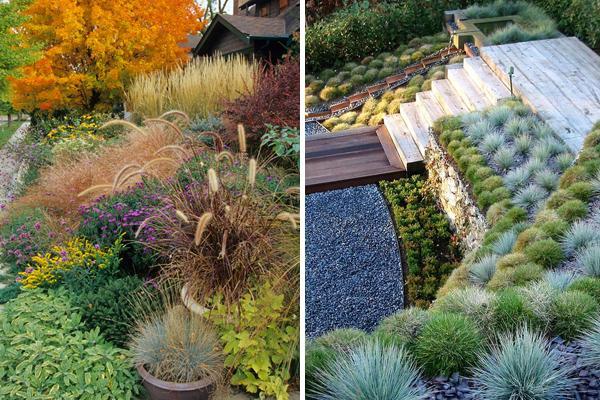

Top dressing
The foxtail pennisetum planted in fertile soil in the first years can not be fed. Adult bushes are fertilized in the spring with organic matter, for example, humus or manure. In the summer, they are spilled once a month with a complex mineral dressing.
Diseases and pests
Pennisetum is rarely affected by pests and diseases. In a summer that is too dry, spider mites can appear, which are easily washed off with a stream of water. Young plants can be chosen by aphids, which are removed with soapy water.
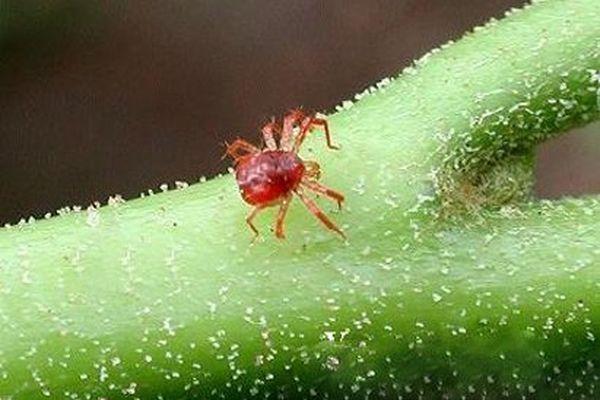

Pruning
You do not need to cut the stems of the foxtail pennisetum for the winter for several reasons:
- Deadwood prevents excessive moisture in the roots.
- Keeps the kidneys from freezing.
- The plot looks decorative not only in summer but also in winter.
Only damaged leaves should be cut for the winter. In the spring, the entire ground part is completely cut off so that young stems can develop.
Mulching
To keep moisture in the root growth area in hot summer, the bushes are mulched with peat, tree bark, sawdust. In addition, mulch will keep the soil layer from crusting after rain or watering.
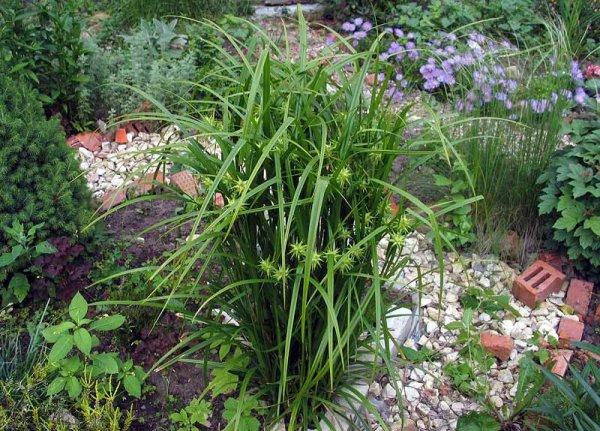

Preparing for winter
Before the onset of frost, the trunk circle is additionally sprinkled with dry foliage, and covered with a special flooring. Another necessary procedure is abundant watering of the roots, since if the ground around them is moist, they are less damaged by frost. To prevent tall stems from ducking under the pressure of snow in winter, they are tied with a rope.
Shelter of the pennisetum for the winter
The culture is thermophilic, but many representatives are adapted to temperate climates. Some species are cultivated as annuals; they can also be grown in flowerpots and brought indoors for the winter. Frost-resistant species successfully overwinter outdoors. With the onset of autumn, the stems should be collected in bunches, tied, covered with spruce branches.
Pruning in the spring will help the plant to wake up and grow. Another option for shelter: cut the stems at the root in the fall, mulch with dry bark, peat or fallen leaves. Can also be potted and stored indoors until spring.
If the winters in your area are harsh, the bush will decrease in size every year. After 2-3 years, it will need to be replaced with a new one.
Where to buy planting material?
You can purchase both seeds and seedlings of the plant. The price of planting material depends on the region of purchase and the variety.
The most expensive option is to purchase seedlings. This option has its advantages:
- Rapid rooting of the plant;
- More lush bloom;
- The plant actively grows and provides plots for further reproduction.
Average ratio of prices to popular plant varieties:
| Plant name | price, rub. |
| Pennisetum foxtail | 400-800 |
| Red Head variety | 900-1600 |
| Hameln variety | 350-550 |
| Carley Rose variety | 550-700 |
| Cassian variety | 700-800 |
| Pennisetum gray | 400-800 |
A more economical option is planting a crop from seeds, the price of such material varies around 30-150 rubles, depending on the variety.
Reproduction of cereals
The pinnate can be propagated by seeds, and perennial species can also be propagated by dividing the bushes. It is difficult to buy ready-made seedlings, usually you have to grow them yourself. Pennisetum does not like when its roots are exposed, so planting on seedlings is done in pots. Of these, the plants are transplanted to a permanent place with a clod of earth. Landing is done as follows:
- Seeds for seedlings are planted in mid-April.
- They are slightly buried in the ground and not sprinkled on top.
- In good lighting, sprouts appear in one to three weeks.
- Seedlings are planted in the ground at the end of May, when the height of the seedlings reaches 10 cm. Plants are planted at a distance of 50-70 cm.
When grown in a seedless way, seeds are planted in open ground in May, when the frost ends. Perennial varieties are propagated by division in the spring. For this, shoots with roots are separated from the bush and transferred to a new place. Pennisetum tolerates transplantation and blooms in the same year.
Growing pennisetum from seeds When to plant
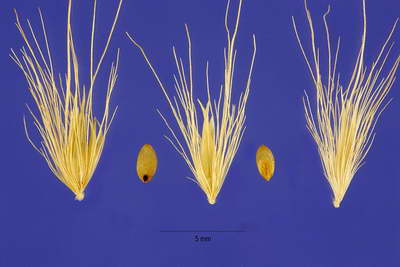

Seeds of pennisetum pinnacle photo
Sowing in open ground
Seeds can be sown in open ground in spring with the establishment of real heat, when the threat of return frost has passed (around May).
Dig up the site, level it. Scatter the seeds over the surface - they are very small, you do not need to deepen them deeply into the soil, it is enough to close them up with a rake. Moisten the garden without stagnant water. Thin the seedlings that appear soon, leaving a distance of about 80 cm between the individual bushes.
Self-seeding is possible under favorable conditions. It is advisable to plant the plant along fences, fences, buildings. To get flowering early, you should grow pinnate seedlings.
Growing seedlings of pinnate bristles
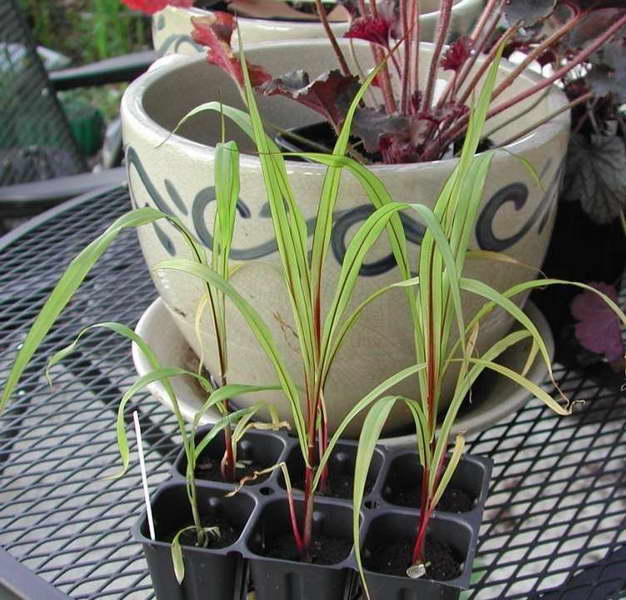

Pennisetum growing from seeds photo seedlings
We do not recommend purchasing seedlings in containers - in most cases they do not take root well. Growing it yourself is not difficult.
- Start sowing pinnate bristles in late February and early March.
- You will need loose, nutritious soil: you can use universal seedling soil.
- It is better to grow immediately in individual containers, since during transplantation, the bare root system should not be allowed. Peat or plastic cups are ideal - in the future, transfer along with an earthen ball.
- Place 1-2 seeds in one container, slightly pressing into the ground.
- Spray from a fine spray, cover crops with cling film, transparent oilcloth or glass.
- Germinate at normal room temperature, provide bright, diffused lighting.
- Expect sprouting in 7-10 days.
- Ventilate the greenhouse, maintain moderate soil moisture. Then remove the shelter.
- Young sprouts will need additional lighting and moderate watering, the temperature of the content is in the range of 20-22 ° C.
Transplant outdoors in May. The plant height will be 10-15 cm.
Distribution and habitats
Pennisetum is a thermophilic plant, which should be round and warm and light. In natural habitat, the homeland of the pennisetum is the southern part of Africa. A large number of pennisetum species are found in South America. You can meet certain species in India, Indochina, Burma, Pakistan, the Arabian Peninsula. Varieties grow on the Eurasian continent - in East Asia, Western Siberia. Cultivated varieties and hybrids can be found on all continents.
Most of the species prefer to grow in subtropical and tropical areas. The cultivated species do well enough in the temperate climate of the European Plain.So, you can meet pennisetum in the southern regions of Russia, Ukraine, Belarus. Some species grow in the Caucasus. In these areas, pinnate bristle is grown as an annual plant. Some perennials are covered and insulated for the winter with material that prevents the roots from freezing.
Pennisetum prefers to grow in open areas - in fields, meadows. The plant is not afraid of drafts and winds. Prefers sunny or shaded places. The plant does not tolerate growing in the shade.
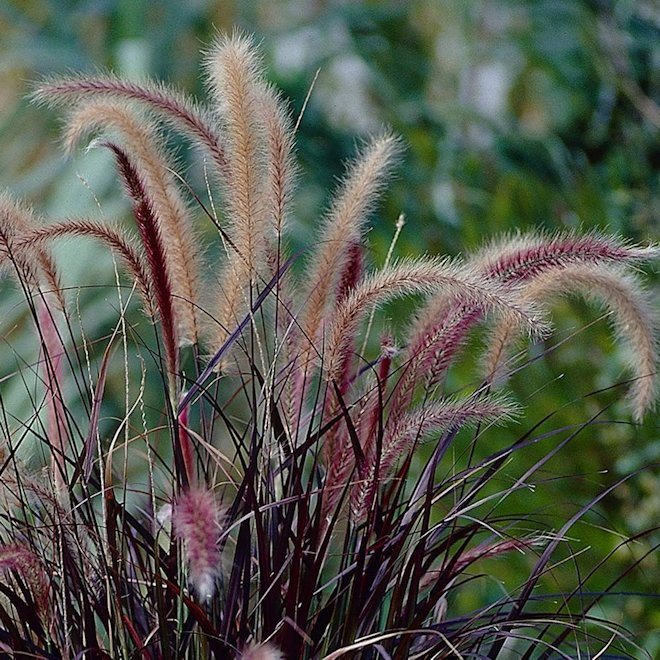

How to care for pinnacle
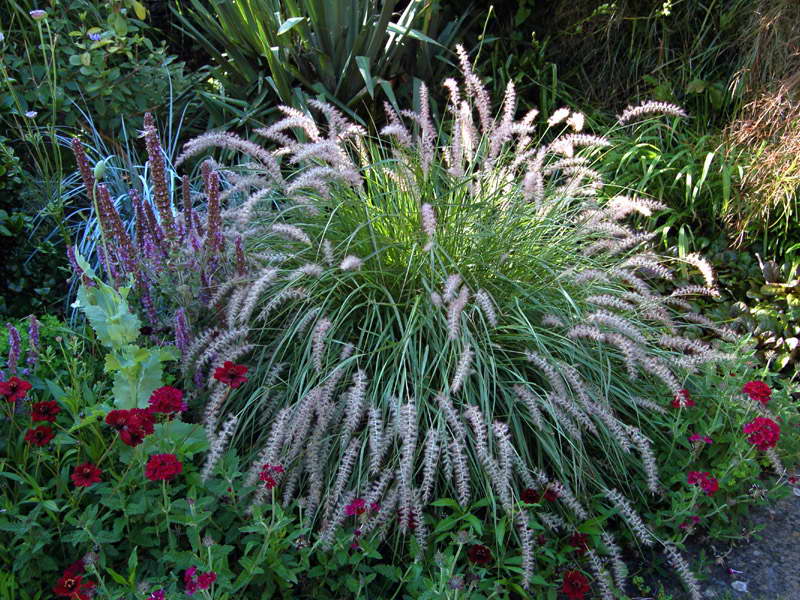

Pennisetum oriental cultivation from seeds planting and care
Weed young plants from weeds, loosen the soil regularly.
Prolonged drought is contraindicated for cereals, and categorically does not tolerate waterlogging of the soil. Focus on precipitation. Water regularly and in moderation, keeping the soil slightly moist.
In the summertime, apply monthly fertilizing. Complex mineral fertilizers and organics are suitable.
Conditions for growing pinnacle
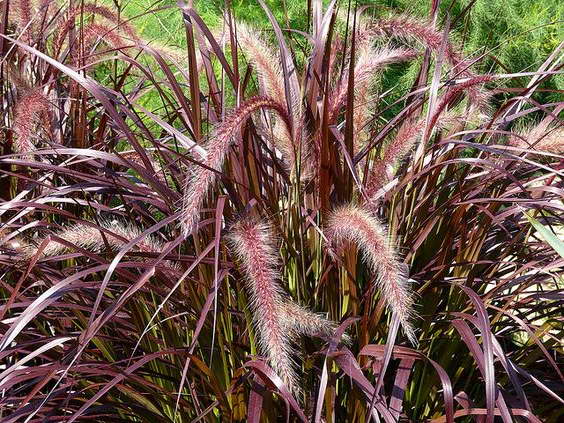

Pennisetum bristly cultivation and care in the open field
The culture is native to hot countries, should be grown under bright sunlight. Take care of protection from drafts. When growing in a flowerpot, container, create the same conditions.
Botanical description
Most members of the Pennisetum genus are perennials, but in cool climates they turned into annuals. Bushes grow in height from 15 to 130 centimeters. Some species can be up to two meters.
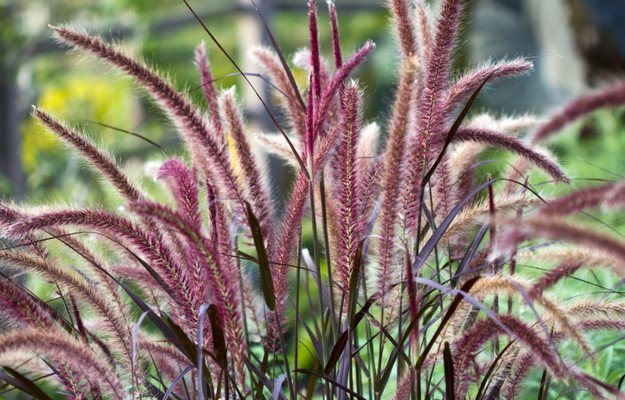

It grows very quickly, forming thickets of globular shrubs. They have straight bare stems, lanceolate foliage, concentrated at the base of the plant. At the end of the long stem, neat lush spikelets flaunt.
They can be white, pink, greenish, burgundy, gray shades. In some species, the stems bend to the ground under the weight of the spikelets.
Did you know? The Latin name of the genus Pennisetum was obtained by merging two words: penni, which means feather and seta, bristle.
Pennisetum or pinnate bristle
Pennisetum (Pennisetum) or pinnate bristle is a genus of perennial plants of the Cereals family. In nature, representatives of the genus are distributed mainly in the tropics and subtropics, some species are found in temperate climatic zones. Most of them are in Africa and South America.
Pennicettum is not often found in our gardens, but is gradually becoming more and more popular. This is due to the fact that most interesting ornamental species do not tolerate cold and frosty winters. The cold-hardy species Pennisetum is foxtail, but it can also freeze out in the middle lane. Some of its garden varieties winter much better, but it is not always possible to obtain the necessary seeds.
Plant height ranges from 20cm to one and a half meters, depending on the species. The shape of the pennisetum bush resembles a fountain. It is often called "fountain grass". Its stems are erect, leaf blades are thin and linear, beautifully bent.
By the middle of summer, the bush is decorated with fluffy inflorescences-spikelets. Their length is from 3 to 35 cm, the color is silvery, greenish-yellow, pink-brown. The upper parts of the inflorescences of the pennisetum are covered with fluffy bristles and are very attractive. The plant becomes even more beautiful in the autumn, when the foliage turns yellow, and the spikelets retain their color until the very frost.
In winter, the plant remains decorative for a long time, usually until the bush receives a heavy snowfall.
Using
Pennisetum is an excellent tapeworm. Its lush bushes resemble small hills with fountains of inflorescences that sway very beautifully in the wind. Spikelets are spectacular even in winter, when they acquire a silvery color.
Suitable for planting in the background of a flower garden or in a rock garden. Against its background, brightly blooming, low plants look especially good.Also beautiful in combination with ground cover decorative representatives of the flora.
Fountains of tall varieties will decorate walls and fences, and can also be used for site zoning. The pinnate is suitable for decorating the coastal area and stony masonry.
Lush spikelets are used to compose bouquet arrangements. To do this, they are dried at the beginning of flowering. You can use both natural shades of various varieties and dye the resulting material with special dyes.
General information
The name of the plant comes from two Latin words that, translated into Russian, sound like "bristle" and "feather". They are a description of the appearance of a blooming pennisetum. In the garden of our climatic zone, the culture can not be found often, since it does not withstand severe frosts, therefore it is mainly grown in tubs, which are removed to the basement for the winter. But this does not prevent the plant from gaining popularity among landscape designers and gardeners.
Popularly, this luxurious herbaceous perennial is called "fountain grass", as its inflorescences are similar to the water jets of a fountain, framed by lush green foliage.
Exotic pinnate bristles are easy to propagate and grow. It does not need special care, and its decorative effect is worth decorating your garden with this plant.
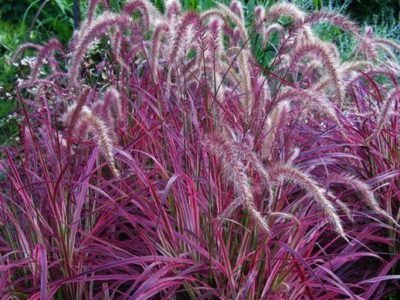

Pennisutum Growing Tips
Lighting. Pennisetums prefer a sunny location, especially in cooler climates.
The soil. Peristochaetae adapt well to different types of soils, but moist fertile soil is required for the growth of a large and lush bush. On dry sandy areas, a small bump will turn out, you don't have to wait for flowering.
Watering. Watering is required only during dry periods.
Fertilizer. On fertile soils, you do not need to fertilize. Perennial species, especially tall ones, are fed with a full complex fertilizer once a month.
Wintering. Pennisetums are thermophilic, Pennisetum foxtail and Pennisetum simple and some garden varieties, apparently derived from them, can withstand frosty winters. Pennisetum gray is used as an annual plant. Can be grown in containers that are taken out into the garden for the summer, and in the fall, before frost, they are removed in a bright room.
Reproduction. Annuals are propagated by seeds, perennials are propagated by seeds or by dividing bushes. The species cultivated in annual crops are sown in pots in spring, in the first decade of May (or when the threat of frost has passed) they are transferred to a flower garden. Can be sown in late April-early May in open ground under a film.

